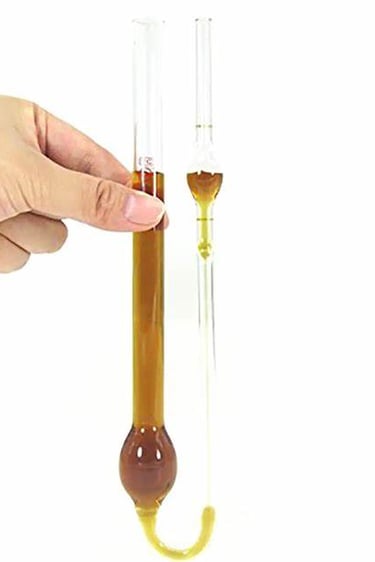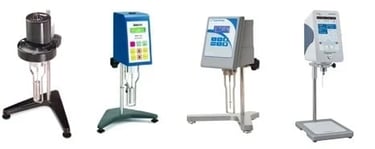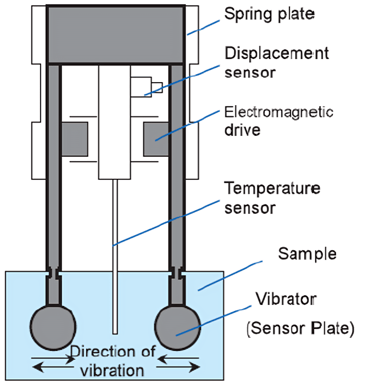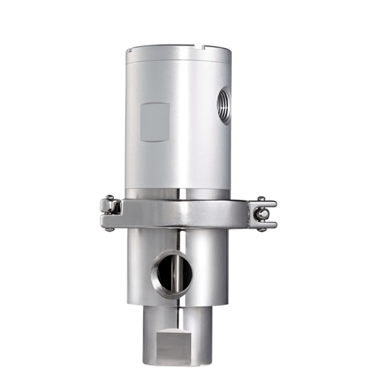Viscosity
Viscosity is a crucial property in various industries, influencing fluid flow, processing, and product performance. It measures a fluid's resistance to deformation, impacting applications such as lubrication, food processing, and pharmaceuticals. Accurate viscosity measurements ensure quality control and compliance with industry standards. Key standards include ASTM D445 for kinematic viscosity and ISO 3104 for liquid petroleum products. These guidelines provide methods for testing and ensure consistency across products. Industries use viscometers and rheometers to monitor viscosity in real-time, helping optimize processes, improve product formulations, and enhance operational efficiency while adhering to safety and regulatory requirements.
A viscometer is a measuring instrument used to determine the viscosity of a liquid. Viscometers are used in the chemical industry, for example, to measure the viscosity of adhesives and paints. Viscosity is also very important in the food and beverage industry. Even food products made in the same way may not be viable as products if they have different viscosities, so viscometers are widely used in the food and beverage industries.
Viscometers can be divided into two main types: those that simply measure the time it takes for a liquid to pass from the top to the bottom, and those that use a rotating spindle.
Viscometers are used in the food, beverage, and chemical industries to measure the viscosity of products.
If the taste is the same, but the viscosity is different, the sensation when pouring into a container or the sensation when actually drinking the product will be different, resulting in a completely different food product. Therefore, viscosity is an important indicator of food products. Viscosity is also an important indicator of the chemical industry. If the viscosity is high, for example, an adhesive applied to a wall will not drip, making it easy to use, but on the other hand, it will be difficult to handle and handle.
What Is a Viscometer?
Uses of Viscometers


Working principle of Viscometers
Viscometers are devices used to measure the viscosity of liquids. Viscometers are based on a variety of principles, but the main principles used are as follows:
The viscosity of a liquid is measured by measuring the damping of vibration by a vibrating body. When a vibrating body vibrates in a liquid, the vibration is damped by the viscous resistance generated in the liquid. By measuring the degree of damping, the viscosity of the liquid is calculated.
Viscosity of a liquid is measured by measuring the flow velocity and the pressure drop of the fluid as it flows through a pipe. Liquid is poured into a pipe set to flow at a constant flow rate and the pressure drop is measured. If the viscosity of the liquid is high, the pressure drop will be large, and thus viscosity can be measured.
Viscosity of a liquid is measured by measuring the speed of a small sphere falling into the liquid and the time taken by the fluid to flow down. Since the speed of a falling sphere and the time it takes for the fluid to flow depend on the viscosity of the liquid, the viscosity of the liquid is calculated by measuring these speeds.
Vibration Damping
Pressure Loss
Falling Velocity (Time)
1. Dynamic Viscosity (η)
Dynamic viscosity measures a fluid's resistance to flow under an applied force. It represents how "thick" or "sticky" a fluid is. Think of honey flowing slowly compared to water. Here's how we derive it:
Equation:
η = τ
γ˙
Where:
η : Dynamic viscosity
τ : Shear stress
γ˙ : Shear rate
Units:
SI: [Pa·s] (Pascal-second) or [mPa·s] (millipascal-second)
1 Pa = 1000mPaOther: [P] (Poise) or [cP] (centipoise)
1 P = 100 cP
1 cP = 1 mPa
Dynamic viscosity is widely used in life sciences and fluid dynamics research.
2. Kinematic Viscosity (ν)
Kinematic viscosity measures how a fluid flows under gravity. It’s the ratio of dynamic viscosity to the fluid’s density:
Equation:
ν = η
ρ
Where:
ν : Kinematic viscosity
η : Dynamic viscosity
ρ : Density
Units:
SI: [m²/s] (square meters per second) or [mm²/s] (square millimeters per second)
1 m²/s=1,000,000 mm²/s
Other: St (stokes) or cSt (centistokes)
1 St = 100 cSt
1 cSt =1 mm²/s
Kinematic viscosity is crucial for applications like measuring the flow of fuels and lubricants.
3. Relative Viscosity (ηr)
Relative viscosity compares the viscosity of a solution (usually a polymer solution) to that of a pure solvent. This helps determine polymer quality, which depends on molar mass.
Equation:
ηr = η
η0
Where:
ηr : Relative viscosity
η : Viscosity of the solution
η0 : Viscosity of the pure solvent
Relative viscosity is dimensionless and forms the basis for other viscosity-related parameters like intrinsic viscosity and molar mass.
4. Apparent Viscosity
This type applies to fluids whose viscosity changes with shear rate (shear-dependent fluids). For example, shampoo becomes less viscous when you shake or squeeze it.
Example:
η (γ˙=60s−1) = 398 mPa
Types of Viscosity


Innovation House
Mon-Sat 9am-7pm

contact@nextagen.in

+91 2654059388
© 2024 Nextagen Analytics Private Limited . All Rights Reserved.







